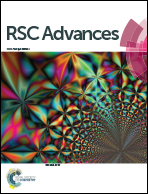Design of bristle-like TiO2–MWCNT nanotubes to improve the dielectric and interfacial properties of polymer-based composite films
Abstract
TiO2–MWCNT heterostructure nanotubes have been fabricated via a solvent-thermal method. Energy dispersive spectrometer and X-ray diffraction analysis revealed that the nanotubes are composed of C, Ti and O elements and TiO2 only contains the tetragonal anatase phase. SEM and TEM results show that most of the TiO2 bristles are vertically studded on the surface of the MWCNT. Subsequently, TiO2–MWCNT/polyarylene ether nitrile (PEN) composite films were prepared in order to investigate the effect of TiO2–MWCNT on the PEN matrix. SEM images exhibit that there is strong interfacial adhesion between the PEN matrix and fillers owing to the special bristle-like structure. Thermal analysis results show that TiO2–MWCNT/PEN composite films possess excellent thermal properties endowed by the PEN matrix. Besides, the dielectric constant of the composite films increases from 4 to 109 at 100 Hz when the TiO2–MWCNT loading reaches 8 wt%. Rheology measurements reveal that there is an obvious difference between the rheological percolation threshold and the electrical percolation threshold.


 Please wait while we load your content...
Please wait while we load your content...